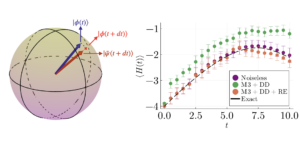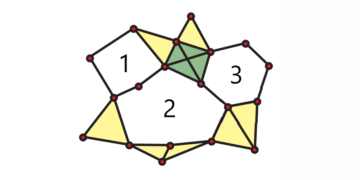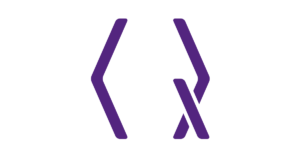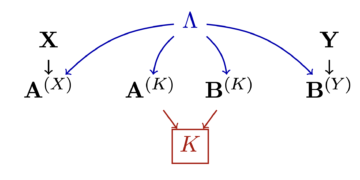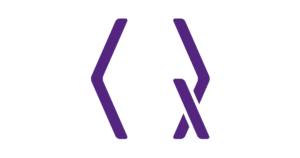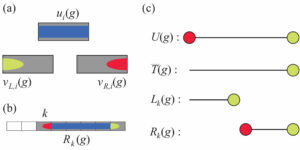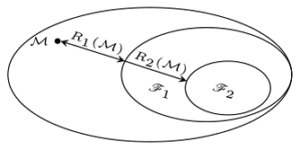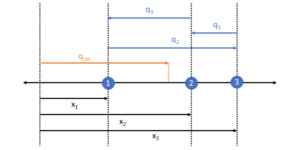1School of Physics and Optoelectronics Engineering, Anhui University, 230601 Hefei, People’s Republic of China
2Naturwissenschaftlich-Technische Fakultät, Universität Siegen, Walter-Flex-Straße 3, 57068 Siegen, Germany
3Departamento de Física Aplicada II, Universidad de Sevilla, E-41012 Sevilla, Spain
4Departamento de Matemática Aplicada I, Universidad de Sevilla, E-41012 Sevilla, Spain
5Instituto Universitario de Investigación de Matemáticas Antonio de Castro Brzezicki, Universidad de Sevilla, E-41012 Sevilla, Spain
6Instituto Carlos I de Física Teórica y Computacional, Universidad de Sevilla, E-41012 Sevilla, Spain
Find this paper interesting or want to discuss? Scite or leave a comment on SciRate.
Abstract
Bell inequality tests where the detection efficiency is below a certain threshold $eta_{rm{crit}}$ can be simulated with local hidden-variable models. Here, we introduce a method to identify Bell tests requiring low $eta_{rm{crit}}$ and relatively low dimension $d$ of the local quantum systems. The method has two steps. First, we show a family of bipartite Bell inequalities for which, for correlations produced by maximally entangled states, $eta_{rm{crit}}$ can be upper bounded by a function of some invariants of graphs, and use it to identify correlations that require small $eta_{rm{crit}}$. We present examples in which, for maximally entangled states, $eta_{rm{crit}} le 0.516$ for $d=16$, $eta_{rm{crit}} le 0.407$ for $d=28$, and $eta_{rm{crit}} le 0.326$ for $d=32$. We also show evidence that the upper bound for $eta_{rm{crit}}$ can be lowered down to $0.415$ for $d=16$ and present a method to make the upper bound of $eta_{rm{crit}}$ arbitrarily small by increasing the dimension and the number of settings. All these upper bounds for $eta_{rm{crit}}$ are valid (as it is the case in the literature) assuming no noise. The second step is based on the observation that, using the initial state and measurement settings identified in the first step, we can construct Bell inequalities with smaller $eta_{rm{crit}}$ and better noise robustness. For that, we use a modified version of Gilbert’s algorithm that takes advantage of the automorphisms of the graphs used in the first step. We illustrate its power by explicitly developing an example in which $eta_{rm{crit}}$ is $12.38%$ lower and the required visibility is $14.62%$ lower than the upper bounds obtained in the first step. The tools presented here may allow for developing high-dimensional loophole-free Bell tests and loophole-free Bell nonlocality over long distances.
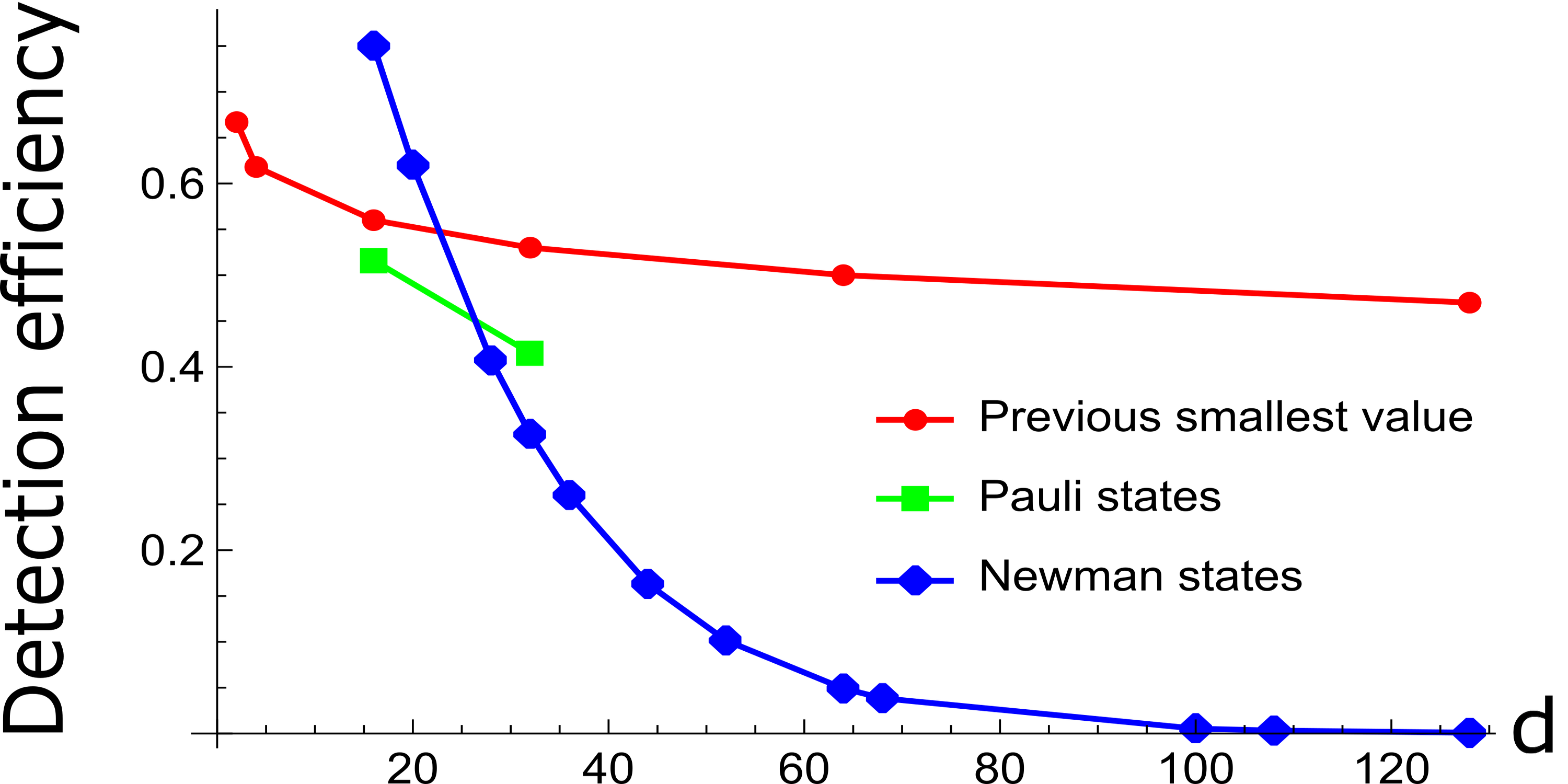
Featured image: Detection efficiency as a function of the dimension $d$ of the local system.
Popular summary
In this work, we identify quantum correlations and Bell inequalities which require a low threshold detection efficiency and relatively low dimension. For that, we first show a family of Bell inequalities and quantum correlations in which the threshold detection efficiency can be expressed in terms of invariants of some graphs with certain properties. We use this connection to identify cases with low threshold detection efficiency. Then, we optimize the resulting Bell inequalities by developing a version of Gilbert’s algorithm that takes advantage of the symmetries. As a result, we obtain threshold detection efficiencies $32$.
► BibTeX data
► References
[1] J. S. Bell, On the Einstein Podolsky Rosen paradox, Physics 1, 195 (1964).
https://doi.org/10.1103/PhysicsPhysiqueFizika.1.195
[2] N. Brunner, D. Cavalcanti, S. Pironio, V. Scarani, and S. Wehner, Bell nonlocality, Rev. Mod. Phys. 86, 419 (2014).
https://doi.org/10.1103/RevModPhys.86.419
[3] P. M. Pearle, Hidden-variable example based upon data rejection, Phys. Rev. D 2, 1418 (1970).
https://doi.org/10.1103/PhysRevD.2.1418
[4] As explained in Ref. Pearle70.
[5] R. Colbeck, Quantum and Relativistic Protocols for Secure Multi-Party Computation, PhD thesis, University of Cambridge, 2006; arXiv:0911.3814.
https://doi.org/10.48550/arXiv.0911.3814
arXiv:0911.3814
[6] S. Pironio, A. Acín, S. Massar, A. Boyer de la Giroday, D. N. Matsukevich, P. Maunz, S. Olmschenk, D. Hayes, L. Luo, T. A. Manning, and C. Monroe, Random numbers certified by Bell’s theorem, Nature 464, 1021 (2010).
https://doi.org/10.1038/nature09008
[7] W.-Z. Liu, M.-H. Li, S. Ragy, S.-R. Zhao, B. Bai, Y. Liu, P. J. Brown, J. Zhang, R. Colbeck, J. Fan, Q. Zhang, and J.-W. Pan, Device-independent randomness expansion against quantum side information, Nat. Phys. 17, 448 (2021).
https://doi.org/10.1038/s41567-020-01147-2
[8] L. K. Shalm, Y. Zhang, J. C. Bienfang, C. Schlager, M. J. Stevens, M. D. Mazurek, C. Abellán, W. Amaya, M. W. Mitchell, M. A. Alhejji, H. Fu, J. Ornstein, R. P. Mirin, S. W. Nam, and E. Knill, Device-independent randomness expansion with entangled photons, Nat. Phys. 17, 452 (2021).
https://doi.org/10.1038/s41567-020-01153-4
[9] A. K. Ekert, Quantum cryptography based on Bell’s theorem, Phys. Rev. Lett. 67, 661 (1991).
https://doi.org/10.1103/PhysRevLett.67.661
[10] D. Mayers and A. Yao, Quantum cryptography with imperfect apparatus, Proceedings 39th Annual Symposium on Foundations of Computer Science (IEEE, Los Alamitos, CA, 1998), p. 503.
https://doi.org/10.1109/SFCS.1998.743501
[11] J. Barrett, L. Hardy, and A. Kent, No signaling and quantum key distribution, Phys. Rev. Lett. 95, 010503 (2005).
https://doi.org/10.1103/PhysRevLett.95.010503
[12] A. Acín, N. Brunner, N. Gisin, S. Massar, S. Pironio, and V. Scarani, Device-independent security of quantum cryptography against collective attacks, Phys. Rev. Lett. 98, 230501 (2007).
https://doi.org/10.1103/PhysRevLett.114.220403
[13] S. Pironio, A. Acín, N. Brunner, N. Gisin, S. Massar, and V. Scarani, Device-independent quantum key distribution secure against collective attacks, New J. Phys. 11, 045021 (2009).
https://doi.org/10.1088/1367-2630/11/4/045021
[14] M. Giustina, M. A. M. Versteegh, S. Wengerowsky, J. Handsteiner, A. Hochrainer, K. Phelan, F. Steinlechner, J. Kofler, J.-Å. Larsson, C. Abellán, W. Amaya, V. Pruneri, M. W. Mitchell, J. Beyer, T. Gerrits, A. E. Lita, L. K. Shalm, S. W. Nam, T. Scheidl, R. Ursin, B. Wittmann, and A. Zeilinger, Significant-loophole-free test of Bell’s theorem with entangled photons, Phys. Rev. Lett. 115, 250401 (2015).
https://doi.org/10.1103/PhysRevLett.115.250401
[15] L. K. Shalm, E. Meyer-Scott, B. G. Christensen, P. Bierhorst, M. A. Wayne, M. J. Stevens, T. Gerrits, S. Glancy, D. R. Hamel, M. S. Allman, K. J. Coakley, S. D. Dyer, C. Hodge, A. E. Lita, V. B. Verma, C. Lambrocco, E. Tortorici, A. L. Migdall, Y. Zhang, D. R. Kumor, W. H. Farr, F. Marsili, M. D. Shaw, J. A. Stern, C. Abellán, W. Amaya, V. Pruneri, T. Jennewein, M. W. Mitchell, P. G. Kwiat, J. C. Bienfang, R. P. Mirin, E. Knill, and S. W. Nam, Strong loophole-free test of local realism, Phys. Rev. Lett. 115, 250402 (2015).
https://doi.org/10.1103/PhysRevLett.115.250402
[16] W. Rosenfeld, D. Burchardt, R. Garthoff, K. Redeker, N. Ortegel, M. Rau, and H. Weinfurter, Event-ready Bell test using entangled atoms simultaneously closing detection and locality loopholes, Phys. Rev. Lett. 119, 010402 (2017).
https://doi.org/10.1103/PhysRevLett.119.010402
[17] B. Hensen, H. Bernien, A. E. Dréau, A. Reiserer, N. Kalb, M. S. Blok, J. Ruitenberg, R. F. L. Vermeulen, R. N. Schouten, C. Abellán, W. Amaya, V. Pruneri, M. W. Mitchell, M. Markham, D. J. Twitchen, D. Elkouss, S. Wehner, T. H. Taminiau, and R. Hanson, Loophole-free Bell inequality violation using electron spins separated by 1.3 kilometres, Nature 526, 682 (2015).
https://doi.org/10.1038/nature15759
[18] I. Pitowsky, Quantum Probability – Quantum Logic, Lecture Notes in Physics 321 (Springer, Berlin, 1989).
https://doi.org/10.1007/BFb0021186
[19] A. Garg and N. D. Mermin, Detector inefficiencies in the Einstein-Podolsky-Rosen experiment, Phys. Rev. D 35, 3831 (1987).
https://doi.org/10.1103/PhysRevD.35.3831
[20] J. F. Clauser, M. A. Horne, A. Shimony, and R. A. Holt, Proposed experiment to test local hidden-variable theories, Phys. Rev. Lett. 23, 880 (1969).
https://doi.org/10.1103/PhysRevLett.23.880
[21] P. H. Eberhard, Background level and counter efficiencies required for a loophole-free Einstein-Podolsky-Rosen experiment, Phys. Rev. A 47, R747(R) (1993).
https://doi.org/10.1103/PhysRevA.47.R747
[22] J. F. Clauser and M. A. Horne, Experimental consequences of objective local theories, Phys. Rev. D. 10 526 (1974).
https://doi.org/10.1103/PhysRevD.10.526
[23] N. Brunner and N. Gisin, Partial list of bipartite Bell inequalities with four binary settings, Phys. Lett. A 372, 3162 (2008).
https://doi.org/10.1016/j.physleta.2008.01.052
[24] E. Zambrini Cruzeiro and N. Gisin, Complete list of tight Bell inequalities for two parties with four binary settings, Phys. Rev. A 99, 022104 (2019).
https://doi.org/10.1103/PhysRevA.99.022104
[25] S. Massar, Nonlocality, closing the detection loophole, and communication complexity, Phys. Rev. A 65, 032121 (2002).
https://doi.org/10.1103/PhysRevA.65.032121
[26] T. Vértesi, S. Pironio, and N. Brunner, Closing the detection loophole in Bell experiments using qudits, Phys. Rev. Lett. 104, 060401 (2010).
https://doi.org/10.1103/PhysRevLett.104.060401
[27] I. Márton, E. Bene, and T. Vértesi, Bounding the detection efficiency threshold in Bell tests using multiple copies of the two-qubit maximally entangled state, Phys. Rev. A 107, 022205 (2023).
https://doi.org/10.1103/PhysRevA.107.022205
[28] N. Miklin, A. Chaturvedi, M. Bourennane, M. Pawłowski, and A. Cabello, Exponentially decreasing the critical detection efficiency for any Bell inequality, Phys. Rev. Lett. 129, 230403 (2022).
https://doi.org/10.1103/PhysRevLett.129.230403
[29] J.-Å. Larsson and J. Semitecolos, Strict detector-efficiency bounds for $n$-site Clauser-Horne inequalities, Phys. Rev. A 63, 022117 (2001).
https://doi.org/10.1103/PhysRevA.63.022117
[30] A. Cabello, D. Rodríguez, and I. Villanueva, Necessary and sufficient detection efficiency for the Mermin inequalities, Phys. Rev. Lett. 101, 120402 (2008).
https://doi.org/10.1103/PhysRevLett.101.120402
[31] K. F. Pál, T. Vértesi, and N. Brunner, Closing the detection loophole in multipartite Bell tests using Greenberger-Horne-Zeilinger states, Phys. Rev. A 86, 062111 (2012).
https://doi.org/10.1103/PhysRevA.86.062111
[32] A. Cabello and J.-Å. Larsson, Minimum detection efficiency for a loophole-free atom-photon Bell experiment, Phys. Rev. Lett. 98, 220402 (2007).
https://doi.org/10.1103/PhysRevLett.98.220402
[33] N. Brunner, N. Gisin, V. Scarani, and C. Simon, Detection loophole in asymmetric Bell experiments, Phys. Rev. Lett. 98, 220403 (2007).
https://doi.org/10.1103/PhysRevLett.98.220403
[34] G. Garbarino, Minimum detection efficiencies for a loophole-free observable-asymmetric Bell-type test, Phys. Rev. A 81, 032106 (2010).
https://doi.org/10.1103/PhysRevA.81.032106
[35] M. Araújo, M. T. Quintino, D. Cavalcanti, M. França Santos, A. Cabello, and M. Terra Cunha, Tests of Bell inequality with arbitrarily low photodetection efficiency and homodyne measurements, Phys. Rev. A 86, 030101(R) (2012).
https://doi.org/10.1103/PhysRevA.86.030101
[36] J. Å. Larsson, Loopholes in Bell inequality tests of local realism, J. Phys. A: Math. Theor. 47, 424003 (2014).
https://doi.org/10.1088/1751-8113/47/42/424003
[37] J. Hofmann, M. Krug, N. Ortegel, L. Gérard, M. Weber, W. Rosenfeld, and H. Weinfurter, Heralded entanglement between widely separated atoms, Science 337, 72 (2012).
https://doi.org/10.1126/science.1221856
[38] T. C. Ralph and A. P. Lund, Nondeterministic noiseless linear amplification of quantum systems, AIP Conference Proceedings 1110, 155 (2009).
https://doi.org/10.1063/1.3131295
[39] N. Gisin, S. Pironio, and N. Sangouard, Proposal for implementing device-independent quantum key distribution based on a heralded qubit amplifier, Phys. Rev. Lett. 105, 070501 (2010).
https://doi.org/10.1103/PhysRevLett.105.070501
[40] C. Branciard, Detection loophole in Bell experiments: How postselection modifies the requirements to observe nonlocality, Phys. Rev. A 83, 032123 (2011).
https://doi.org/10.1103/PhysRevA.83.032123
[41] A. Cabello and F. Sciarrino, Loophole-free Bell test based on local precertification of photon’s presence, Phys. Rev. X 2, 021010 (2012).
https://doi.org/10.1103/PhysRevX.2.021010
[42] E. Meyer-Scott, D. McCloskey, K. Gołos, J. Z. Salvail, K. A. G. Fisher, D. Hamel, A. Cabello, K. J. Resch, and T. Jennewein, Certifying the presence of a photonic qubit by splitting it in two, Phys. Rev. Lett. 116, 070501 (2016).
https://doi.org/10.1103/PhysRevLett.116.070501
[43] M. Giustina, A. Mech, S. Ramelow, B. Wittmann, J. Kofler, J. Beyer, A. Lita, B. Calkins, T. Gerrits, S. W. Nam, R. Ursin, and A. Zeilinger, Bell violation using entangled photons without the fair-sampling assumption, Nature 497, 227 (2013).
https://doi.org/10.1038/nature12012
[44] B. G. Christensen, K. T. McCusker, J. B. Altepeter, B. Calkins, T. Gerrits, A. E. Lita, A. Miller, L. K. Shalm, Y. Zhang, S. W. Nam, N. Brunner, C. C. W. Lim, N. Gisin, and P. G. Kwiat, Detection-loophole-free test of quantum nonlocality, and applications, Phys. Rev. Lett. 111, 130406 (2013).
https://doi.org/10.1103/PhysRevLett.111.130406
[45] Y. Liu, X. Yuan, M. Li, W. Zhang, Q. Zhao, J. Zhong, Y. Cao, Y.-H. Li, L.-K. Chen, H. Li, T. Peng, Y.-A. Chen, C. Peng, S.-C. Shi, Z. Wang, L. You, X. Ma, J. Fan, Q. Zhang, and J.-W. Pan, High-speed device-independent quantum random number generation without a detection loophole, Phys. Rev. Lett. 120, 010503 (2018).
https://doi.org/10.1103/PhysRevLett.120.010503
[46] L. Shen, J. Lee, L. P. Thinh, J.-D. Bancal, A. Cerè, A. Lamas-Linares, A. Lita, T. Gerrits, S. W. Nam, V. Scarani, and C. Kurtsiefer, Randomness extraction from Bell violation with continuous parametric down-conversion, Phys. Rev. Lett. 121, 150402 (2018).
https://doi.org/10.1103/PhysRevLett.121.150402
[47] P. Bierhorst, E. Knill, S. Glancy, Y. Zhang, A. Mink, S. Jordan, A. Rommal, Y.-K. Liu, B. Christensen, S. W. Nam, M. J. Stevens, and L. K. Shalm, Experimentally generated randomness certified by the impossibility of superluminal signals, Nature 556, 223 (2018).
https://doi.org/10.1038/s41586-018-0019-0
[48] Y. Liu, Q. Zhao, M.-H. Li, J.-Y. Guan, Y. Zhang, B. Bai, W. Zhang, W.-Z. Liu, C. Wu, X. Yuan, H. Li, W. J. Munro, Z. Wang, L. You, J. Zhang, X. Ma, J. Fan, Q. Zhang, and J.-W. Pan, Device-independent quantum random-number generation, Nature 562, 548 (2018).
https://doi.org/10.1038/s41586-018-0559-3
[49] M.-H. Li, C. Wu, Y. Zhang, W.-Z. Liu, B. Bai, Y. Liu, W. Zhang, Q. Zhao, H. Li, Z. Wang, L. You, W. J. Munro, J. Yin, J. Zhang, C.-Z. Peng, X. Ma, Q. Zhang, J. Fan, and J.-W. Pan, Test of local realism into the past without detection and locality loopholes, Phys. Rev. Lett. 121, 080404 (2018).
https://doi.org/10.1103/PhysRevLett.121.080404
[50] Y. Zhang, L. K. Shalm, J. C. Bienfang, M. J. Stevens, M. D. Mazurek, S. W. Nam, C. Abellán, W. Amaya, M. W. Mitchell, H. Fu, C. A. Miller, A. Mink, and E. Knill, Experimental low-latency device-independent quantum randomness, Phys. Rev. Lett. 124, 010505 (2020).
https://doi.org/10.1103/PhysRevLett.124.010505
[51] L. K. Shalm, Y. Zhang, J. C. Bienfang, C. Schlager, M. J. Stevens, M. D. Mazurek, C. Abellán, W. Amaya, M. W. Mitchell, M. A. Alhejji, H. Fu, J. Ornstein, R. P. Mirin, S. W. Nam, and E. Knill, Device-independent randomness expansion with entangled photons, Nat. Phys. 17, 452 (2021).
https://doi.org/10.1038/s41567-020-01153-4
[52] M.-H. Li, X. Zhang, W.-Z. Liu, S.-R. Zhao, B. Bai, Y. Liu, Q. Zhao, Y. Peng, J. Zhang, Y. Zhang, W. J. Munro, X. Ma, Q. Zhang, J. Fan, and J.-W. Pan, Experimental realization of device-independent quantum randomness expansion, Phys. Rev. Lett. 126, 050503 (2021).
https://doi.org/10.1103/PhysRevLett.126.050503
[53] W.-Z. Liu, M.-H. Li, S. Ragy, S.-R. Zhao, B. Bai, Y. Liu, P. J. Brown, J. Zhang, R. Colbeck, J. Fan, Q. Zhang, and J.-W. Pan, Device-independent randomness expansion against quantum side information, Nat. Phys. 17, 448 (2021).
https://doi.org/10.1038/s41567-020-01147-2
[54] W.-Z. Liu, Y.-Z. Zhang, Y.-Z. Zhen, M.-H. Li, Y. Liu, J. Fan, F. Xu, Q. Zhang, and J.-W. Pan, Photonic verification of device-independent quantum key distribution against collective attacks, Phys. Rev. Lett. 129, 050502 (2022).
https://doi.org/10.1103/PhysRevLett.129.050502
[55] J.-L. Chen, A. Cabello, Z.-P. Xu, H.-Y. Su, C. Wu, and L. C. Kwek, Hardy’s paradox for high-dimensional systems, Phys. Rev. A 88, 062116 (2013).
https://doi.org/10.1103/PhysRevA.88.062116
[56] T. K. Lo and A. Shimony, Proposed molecular test of local hidden-variables theories, Phys. Rev. A 23, 3003 (1981).
https://doi.org/10.1103/PhysRevA.23.3003
[57] D. Collins and N. Gisin, A relevant two qubit Bell inequality inequivalent to the CHSH inequality, J. Phys. A: Math. Gen. 37, 1775 (2004).
https://doi.org/10.1088/0305-4470/37/5/021
[58] R. Diestel, Graph Theory, Graduate Texts in Mathematics 173 (Springer, Berlin, 2017).
https://doi.org/10.1007/978-3-662-53622-3
[59] L. Hogben, K. F. Palmowski, D. E. Roberson, and S. Severini, Orthogonal representations, projective rank, and fractional minimum positive semidefinite rank: Connections and new directions, Electron. J. Linear Algebra 32, 98 (2017).
https://doi.org/10.13001/1081-3810.3102
[60] L. Lovász, On the Shannon capacity of a graph, IEEE Trans. Inf. Theory 25, 1 (1979).
https://doi.org/10.1109/TIT.1956.1056798
[61] M. Grötschel, L. Lovász, and A. Schrijver, Relaxations of vertex packings, J. Combin. Theory B 40, 330 (1986).
https://doi.org/10.1016/0095-8956(86)90087-0
[62] C. E. Shannon, The zero-error capacity of a noisy channel. IRE Trans. Inform. Theory 2, 8 (1956).
https://doi.org/10.1109/TIT.1956.1056798
[63] A. Cabello, S. Severini, and A. Winter, (Non-)Contextuality of physical theories as an axiom, Mittag-Leffler-2010fall Report No. 8 (2010).
arXiv:1010.2163
http://www.mittag-leffler.se/sites/default/files/IML-1011f-08.pdf
[64] M. Planat, Quantum states arising from the Pauli groups, symmetries and paradoxes, in Symmetries and Groups in Contemporary Physics. Proceedings of the XXIX International Colloquium on Group-Theoretical Methods in Physics, edited by C. Bai, J.-P. Gazeau, and M. L. Ge, Nankai Series in Pure, Applied Mathematics and Theoretical Physics 11 (World Scientific, Singapore, 2013), p. 295.
https://doi.org/10.1142/9789814518550_0038
[65] M. W. Newman, Independent Sets and Eigenspaces, Ph.D. thesis, University of Waterloo, 2004.
http://hdl.handle.net/10012/1151
[66] M. Reck, A. Zeilinger, H. J. Bernstein, and P. Bertani, Experimental realization of any discrete unitary operator, Phys. Rev. Lett. 73, 58 (1994).
https://doi.org/10.1103/PhysRevLett.73.58
[67] W. R. Clements, P. C. Humphreys, B. J. Metcalf, W. S. Kolthammer, and I. A. Walmsley, Optimal design for universal multiport interferometers, Optica 3, 1460 (2016).
https://doi.org/10.1364/OPTICA.3.001460
[68] M. C. Tichy, M. Tiersch, F. de Melo, F. Mintert, and A. Buchleitner, Zero-transmission law for multiport beam splitters, Phys. Rev. Lett. 104, 220405 (2010).
https://doi.org/10.1103/PhysRevLett.104.220405
[69] A. Crespi, Suppression laws for multiparticle interference in Sylvester interferometers, Phys. Rev. A 91, 013811 (2015).
https://doi.org/10.1103/PhysRevA.91.013811
[70] N. Ito, Hadamard graphs. I, Graphs Comb. 1, 57 (1985).
https://doi.org/10.1007/BF02582929
[71] N. Ito, Hadamard graphs. II, Graphs Comb. 1, 331 (1985).
https://doi.org/10.1007/BF02582961
[72] G. Brassard, R. Cleve, and A. Tapp, The cost of exactly simulating quantum entanglement with classical communication, Phys. Rev. Lett. 83, 1874 (1999).
https://doi.org/10.1103/PhysRevLett.83.1874
[73] V. Galliard, A. Tapp, and S. Wolf, Deterministic quantum non-locality and graph colorings, Theor. Comput. Sci. 486, 20 (2013).
https://doi.org/10.1016/j.tcs.2012.12.013
[74] D. Avis, A quantum protocol to win the graph colouring game on all Hadamard graphs, IEICE Trans. Fundam. Electron. Commun. Comput. Sci. 89, 1378 (2006).
https://doi.org/10.1093/ietfec/e89-a.5.1378
[75] P. J. Cameron, A. Montanaro, M. W. Newman, S. Severini, and A. Winter, On the quantum chromatic number of a graph, Electron. J. Comb. 14, R81 (2007).
https://doi.org/10.37236/999
[76] G. Scarpa and S. Severini, Kochen-Specker sets and the rank-1 quantum chromatic number, IEEE Trans. Inf. Theory 58, 2524 (2012).
https://doi.org/10.1109/TIT.2011.2178018
[77] L. Mančinska and D. E. Roberson, Quantum homomorphisms, J. Combin. Theory Ser. B 118, 228 (2016).
https://doi.org/10.1016/j.jctb.2015.12.009
[78] P. Wocjan and C. Elphick, Spectral lower bounds for the orthogonal and projective ranks of a graph, Electron. J. Comb. 26, 3.45 (2019).
https://doi.org/10.37236/8183
[79] P. Frankl, Orthogonal vectors in the $n$-dimensional cube and codes with missing distances, Combinatorica 6, 279 (1986).
https://doi.org/10.1007/BF02579389
[80] F. Ihringer and H. Tanaka, The independence number of the orthogonality graph in dimension $2^k$, Combinatorica 39, 1425 (2019).
https://doi.org/10.1007/s00493-019-4134-9
[81] J. J. Sylvester, Thoughts on inverse orthogonal matrices, simultaneous sign successions, and tessellated pavements in two or more colours, with applications to Newton’s rule, ornamental tile-work, and the theory of numbers, Philos. Mag. 34, 461 (1867).
https://doi.org/10.1080/14786446708639914
[82] R. E. A. C. Paley, On orthogonal matrices, J. Math. Phys. 4, 311 (1933).
https://doi.org/10.1002/sapm1933121311
[83] H. Kimura, Classification of Hadamard matrices of order 28, Discrete Math. 133, 171 (1994).
https://doi.org/10.1016/0012-365X(94)90024-8
[84] B. D. McKay, Topics in Computational Graph Theory, Ph.D. thesis, University of Melburne, 1980.
https://users.cecs.anu.edu.au/~bdm/papers/McKayPhDThesis.pdf
[85] A. Cabello, M. Kleinmann, and C. Budroni, Necessary and sufficient condition for quantum state-independent contextuality, Phys. Rev. Lett. 114, 250402 (2015).
https://doi.org/10.1103/PhysRevLett.114.250402
[86] D. E. Knuth, The sandwich theorem, Electron. J. Combin. 1, A1 (1994).
https://doi.org/10.37236/1193
[87] R. J. Nowakowski and D. F. Rall, Associative graph products and their independence, domination and coloring numbers, Discuss. Math. Graph Theory 16, 53 (1996).
https://doi.org/10.7151/dmgt.1023
[88] D. Geller and S. Stahl, The chromatic number and other functions of the lexicographic product, J. Comb. Theory. Ser. B 19, 87 (1975).
https://doi.org/10.1016/0095-8956(75)90076-3
[89] D. E. Roberson, Conic formulations of graph homomorphisms, J. Algebr. Comb. 43, 877 (2016).
https://doi.org/10.1007/s10801-016-0665-y
[90] G. F. Royle, and C. E. Praeger, Constructing the vertex-transitive graphs of order 24, J. Symb. Comput. 8, 4 (1989).
https://doi.org/10.1016/S0747-7171(89)80033-1
[91] B. D. McKay and G. F. Royle, The transitive graphs with at most 26 vertices, Ars Combin. 30, 161 (1990).
http://users.cecs.anu.edu.au/~bdm/papers/Transitive26.pdf
[92] D. Holt and G. Royle, A census of small transitive groups and vertex-transitive graphs, J. Symb. Comput. 101, (2020).
arXiv:1811.09015
[93] P. Potočnik, P. Spiga, and G. Verret, Cubic vertex-transitive graphs on up to 1280 vertices, J. Symb. Comput. 50, (2013).
https://doi.org/10.1016/j.jsc.2012.09.002
[94] B. D. McKay, Graphs.
https://users.cecs.anu.edu.au/~bdm/data/graphs.html
[95] L. Lovász, Graphs and Geometry, Institute of Mathematics, Ëotvös University, Budapest, 2019.
http://web.cs.elte.hu/~lovasz/bookxx/geomgraphbook/geombook2019.01.11.pdf
[96] Z.-P. Xu, X.-D. Yu, and M. Kleinmann, State-independent quantum contextuality with projectors of nonunit rank, New J. Phys. 23, 043025 (2021).
https://doi.org/10.1088/1367-2630/abe6e3
[97] A. Cabello, Converting contextuality into nonlocality, Phys. Rev. Lett. 127, 070401 (2021).
https://doi.org/10.1103/PhysRevLett.127.070401
[98] S. Yu and C. H. Oh, State-independent proof of Kochen-Specker theorem with 13 rays, Phys. Rev. Lett. 108, 030402 (2012).
https://doi.org/10.1103/PhysRevLett.108.030402
[99] A. Cabello, M. Kleinmann, and J. R. Portillo, Quantum state-independent contextuality requires 13 rays, J. Phys. A: Math. Theor. 49, 38LT01 (2016).
https://doi.org/10.1088/1751-8113/49/38/38LT01
[100] A. Cabello, Á. Feito, and A. Lamas-Linares, Bell’s inequalities with realistic noise for polarization-entangled photons Phys. Rev. A 72, 052112 (2005).
https://doi.org/10.1103/PhysRevA.72.052112
[101] F. A. Bovino, G. Castagnoli, A. Cabello, and A. Lamas-Linares, Experimental noise-resistant Bell-inequality violations for polarization-entangled photons, Phys. Rev. A 73, 062110 (2006).
https://doi.org/10.1103/PhysRevA.73.062110
[102] N. Herrera Valencia, V. Srivastav, M. Pivoluska, M Huber, N. Friis, W. McCutcheon, and M. Malik, High-dimensional pixel entanglement: Efficient generation and certification, Quantum 4, 376 (2020).
https://doi.org/10.22331/q-2020-12-24-376
[103] E. G. Gilbert, An iterative procedure for computing the minimum of a quadratic form on a convex set, J. SIAM Control 4, 61 (1966).
https://doi.org/10.1137/0304007
[104] A. Montina and S. Wolf, Discrimination of non-local correlations, Entropy 21, 104 (2019).
https://doi.org/10.3390/e21020104
[105] J. Shang and O. Gühne, Convex optimization over classes of multiparticle entanglement, Phys. Rev. Lett. 120, 050506 (2018).
https://doi.org/10.1103/PhysRevLett.120.050506
[106] P. Pandya, O. Sakarya, and M. Wieśniak, Hilbert-Schmidt distance and entanglement witnessing, Phys. Rev. A 102, 012409 (2020).
https://doi.org/10.1103/PhysRevA.102.012409
[107] J. R. Gonzales-Ureta, A. Predojević and A. Cabello, Optimal and tight Bell inequalities for state-independent contextuality sets, arXiv:2207.08850.
https://doi.org/10.48550/arXiv.2207.08850
arXiv:2207.08850
[108] Z.-P. Xu, J. Steinberg, J. Singh, A. J. López-Tarrida, J. R. Portillo, and A. Cabello, Code to accompany Graph-theoretic approach to Bell experiments with low detection efficiency, https://gitlab.com/JoStei1996/symmetric_bell.
https://gitlab.com/JoStei1996/symmetric_bell
Cited by
[1] Junior R. Gonzales-Ureta, Ana Predojević, and Adán Cabello, “Optimal and tight Bell inequalities for state-independent contextuality sets”, arXiv:2207.08850, (2022).
[2] Víctor Zapatero, Tim van Leent, Rotem Arnon-Friedman, Wen-Zhao Liu, Qiang Zhang, Harald Weinfurter, and Marcos Curty, “Advances in device-independent quantum key distribution”, arXiv:2208.12842, (2022).
[3] István Márton, Erika Bene, and Tamás Vértesi, “Bounding the detection efficiency threshold in Bell tests using multiple copies of the maximally entangled two-qubit state carried by a single pair of particles”, arXiv:2103.10413, (2021).
The above citations are from SAO/NASA ADS (last updated successfully 2023-02-18 23:14:38). The list may be incomplete as not all publishers provide suitable and complete citation data.
On Crossref’s cited-by service no data on citing works was found (last attempt 2023-02-18 23:14:36).
This Paper is published in Quantum under the Creative Commons Attribution 4.0 International (CC BY 4.0) license. Copyright remains with the original copyright holders such as the authors or their institutions.
- SEO Powered Content & PR Distribution. Get Amplified Today.
- Platoblockchain. Web3 Metaverse Intelligence. Knowledge Amplified. Access Here.
- Source: https://quantum-journal.org/papers/q-2023-02-16-922/
- 1
- 1.3
- 10
- 100
- 11
- 116
- 1985
- 1994
- 1996
- 1998
- 1999
- 2001
- 2011
- 2012
- 2014
- 2016
- 2017
- 2018
- 2019
- 2020
- 2021
- 2022
- 2023
- 28
- 39
- 67
- 7
- 70
- 77
- 84
- 9
- 98
- a
- above
- ABSTRACT
- access
- advances
- ADvantage
- affiliations
- against
- aip
- algorithm
- All
- Ana
- and
- annual
- applications
- applied
- approach
- assumption
- Attacks
- author
- authors
- background
- based
- Beam
- Bell
- Bell Experiment
- below
- Bernstein
- Better
- between
- BLOK
- Bound
- Break
- Budapest
- CA
- cambridge
- Capacity
- case
- cases
- Census
- certain
- Certification
- Certified
- Channel
- chen
- Christensen
- classes
- classification
- closing
- code
- Collective
- comment
- Commons
- Communication
- complete
- complexity
- computation
- computer
- computer science
- computing
- condition
- Conference
- connection
- Connections
- Consequences
- construct
- constructing
- contemporary
- continuous
- control
- Convex
- copyright
- Cost
- Counter
- critical
- crucial
- cryptography
- data
- Design
- detected
- Detection
- developing
- Dimension
- discuss
- distance
- distribution
- down
- efficiencies
- efficiency
- efficient
- Engineering
- Erika
- evidence
- exactly
- example
- examples
- expansion
- experiment
- explained
- exponentially
- expressed
- family
- fan
- First
- form
- found
- Foundations
- fractional
- from
- function
- functions
- fundamental
- game
- ge
- Gen
- generated
- generation
- graduate
- graph
- graphs
- Group’s
- handle
- harvard
- here
- Hidden
- Hodge
- holders
- How
- However
- HTML
- HTTPS
- identified
- identify
- identifying
- IEEE
- image
- implementing
- in
- Including
- increasing
- independence
- independent
- inequalities
- information
- initial
- Institute
- institutions
- interesting
- Interference
- International
- introduce
- IT
- JavaScript
- Jordan
- journal
- Key
- Last
- Law
- Laws
- Leave
- Lecture
- Lee
- Level
- Li
- License
- List
- literature
- local
- Long
- loopholes
- los
- Low
- make
- many
- math
- mathematics
- max-width
- measurements
- Metcalf
- method
- methods
- Miller
- minimum
- missing
- models
- modified
- molecular
- Month
- more
- most
- multi-party
- multiple
- Nam
- Nature
- necessary
- New
- Newton
- Noise
- Notes
- number
- numbers
- objective
- observe
- obtain
- obtained
- open
- operator
- optimal
- optimization
- Optimize
- order
- original
- Other
- pairs
- Paper
- Paradox
- parties
- past
- people’s
- Photons
- physical
- Physics
- Pixel
- plato
- Plato Data Intelligence
- PlatoData
- positive
- possible
- power
- presence
- present
- presented
- Problem
- Proceedings
- Produced
- Product
- Products
- proof
- properties
- proposal
- proposed
- protocol
- protocols
- Prove
- provide
- published
- publisher
- publishers
- Quantum
- quantum advantage
- quantum cryptography
- quantum entanglement
- quantum systems
- Qubit
- random
- randomness
- ranks
- realistic
- realization
- references
- relatively
- relevant
- remains
- report
- Republic
- require
- required
- Requirements
- requires
- result
- resulting
- Roberson
- robustness
- Rule
- SCI
- Science
- scientific
- Second
- secure
- security
- Series
- set
- Sets
- settings
- show
- siam
- side
- sign
- signals
- Simon
- simultaneously
- since
- Singapore
- single
- small
- smaller
- some
- Spectral
- spins
- State
- States
- Step
- Steps
- Strict
- strong
- Successfully
- such
- sufficient
- suitable
- suppression
- Symposium
- system
- Systems
- takes
- tasks
- terms
- Terra
- test
- tests
- The
- The Graph
- their
- theoretical
- therefore
- threshold
- Tim
- Title
- to
- tools
- Topics
- under
- Universal
- university
- university of cambridge
- updated
- URL
- use
- Values
- Verification
- version
- VIOLATION
- Violations
- visibility
- volume
- W
- which
- widely
- win
- Winter
- without
- witnessing
- Wolf
- Work
- works
- world
- wu
- X
- year
- You
- Yuan
- zephyrnet
- Zhao
- Zhong


